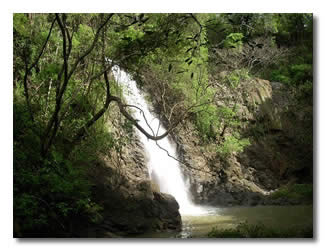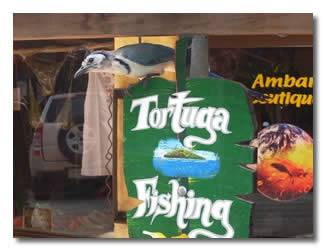Travel for most means adventure. Hop on a plane, venture to a destination never-before experienced and partake in activities only dreamed about previously. Costa Rica as a travel destination is one that guarantees adventure in numerous forms, whatever the desire; hike a volcano, fly like Tarzan (almost) through the treetops, surf amongst alligators or spend a day sport fishing.  Other activities include: Canopy tours; hiking to waterfalls; exploring nature reserves; surfing; riding ATV’s on the beach or through the countryside; scuba diving and snorkeling; horseback riding and whitewater river rafting.
Other activities include: Canopy tours; hiking to waterfalls; exploring nature reserves; surfing; riding ATV’s on the beach or through the countryside; scuba diving and snorkeling; horseback riding and whitewater river rafting.
Canopy Tours
A canopy tour is a sure-fire way to get the adrenalin pumping. Strapped into a harness and connected to a horizontal cable 260 feet or so above ground and up to 1900 feet long, you cross your legs (and maybe your fingers as well) and off you go zipping through the tree tops and over wide expanses of Costa Rican countryside. After a few zip lines you land on a platform and then free-fall approximately 75 feet down on a rope – guides located at the top and bottom of the platform control the rate of speed you travel down the rope and safely bring you to an abrupt stop at the bottom. To round out the exhilarating experience is the Tarzan Swing for one more free-fall rush that lasts longer with some swinging thrown in for good measure. You jump off the edge of the platform attached to a bungee cord, drop approximately 100 feet down then whoosh-out before hitting ground, swinging back and forth until they coral you in with an inner-tube.
For the more sedate traveler there are Hanging Bridges tours where you trek along suspension bridges built atop the cloud forests or jungle accompanied by an experienced nature guide.
In some areas of the country, such as the tourist haven of Montezuma on the Pacific coast, your trek or canopy tour may take you above one or more spectacular, natural waterfalls. In Montes de Oro in the province of Puntarenas you can ride 25 zip lines that cross over eleven waterfalls.
canopy tour may take you above one or more spectacular, natural waterfalls. In Montes de Oro in the province of Puntarenas you can ride 25 zip lines that cross over eleven waterfalls.
Surfing
Surfing locations are found throughout Costa Rica on both the Pacific and Caribbean coasts. On the Pacific side there is Tamarindo Beach in Guanacaste, beaches near the towns of Samara and Malpais on the Nicoya Peninsula and Playa Hermosa in Puntarenas Province. Puerto Viejo in Limon Province is the most popular surf spot on the Caribbean coast and home to the largest wave in Costa Rica – Salsa Brava.
Alligators are actually rare, but American Crocodiles are present in large numbers in some areas in the country, such as National Parks with an abundance of wetlands, swamps and large rivers. Many surf breaks are at river mouths that may house these creatures and the risk of running into one increases during the rainy season from May through mid-November. Know where you are going when planning a trip and what you may encounter.
Whitewater Rafting
Whitewater rafting can be found in the Guanacaste, Central Valley, Central Pacific and Northern Lowlands regions of Costa Rica. The cost of an all-day rafting trip is approximately $70 USD per adult. Half-day trips are around $50 USD. Some outfitters will provide lunch or snacks, others will not. Prices of other activities such as canopy tours, snorkeling, horseback riding or a morning of sport fishing are approximately $40 USD and up per person and usually a good value. A half-day trip typically includes round-trip transportation from your hotel to the outdoor destination and experienced guides plus, or course, any necessary equipment.
Paradise always comes at a price and Costa Rica is no exception, but the adventurous traveler can find lodging and food for every budget. Costs of hostels and hotels can be reasonable at $8-10 USD per bed in a hostel and $20-25 USD for a basic, private double room (more during the high season months of December to April) all the way through to deluxe accommodations. Grocery store items and meals in a restaurant are expensive by Central American standards. You must buy and drink bottled water in most areas, as local water is not safe to drink. A 1.5 liter bottle is approximately $1.25 USD. Casada means ‘married’ in Spanish and is also the word used to refer to the typical Costa Rican midday meal. It is most often the best bargain in a low-end restaurant, or ‘Soda’ as they are called in Costa Rica at around $3 USD. A casada is a plate with a large piece of chicken, beef or pork cutlet and heaping servings of rice, black beans, mashed potatoes (or some version thereof) and salad. If on a budget it’s a life saver.
Molly McHugh is the author of Viva La Baja! Relocation Guide to the Baja California Peninsula that is available for purchase at: http://www.vivalabaja.com. She publishes Viva La Baja! Blog: http://vivalabaja.blogspot.com.
 |



